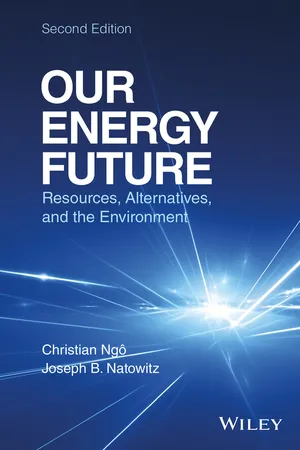
Our Energy Future
Resources, Alternatives and the Environment
- English
- ePUB (mobile friendly)
- Available on iOS & Android
About This Book
Presents an overview on the different aspects of the energy value chain and discusses the issues that future energy is facing
This book covers energy and the energy policy choices which face society. The book presents easy-to-grasp information and analysis, and includes statistical data for energy production, consumption and simple formulas. Among the aspects considered are: science, technology, economics and the impact on health and the environment. In this new edition two new chapters have been added: The first new chapter deals with unconventional fossil fuels, a resource which has become very important from the economical point of view, especially in the United States. The second new chapter presents the applications of nanotechnology in the energy domain.
- Provides a global vision of available and potential energy sources
- Discusses advantages and drawbacks to help prepare current and future generations to use energy differently
- Includes new chapters covering unconventional fossil fuels and nanotechnology as new energy
Our Energy Future: Resources, Alternatives and the Environment, Second Edition, is written for professionals, students, teachers, decision-makers and politicians involved in the energy domain and interested in environmental issues.
Frequently asked questions
Information
CHAPTER 1
We Need Energy
BASIC NATURE OF ENERGY
1.1. GENERALITIES
1.1.1. Primary and Secondary Energy

1.1.2. Energy Units

| Prefix | Multiplicative Factor | Symbol | Prefix | Multiplicative Factor | Symbol |
| Deca | 101 | da | Deci | 10−1 | d |
| Hecto | 102 | h | Centi | 10−2 | c |
| Kilo... |
Table of contents
- COVER
- TITLE PAGE
- TABLE OF CONTENTS
- PREFACE TO THE SECOND EDITION
- PREFACE TO THE FIRST EDITION
- CHAPTER 1: We Need Energy
- CHAPTER 2: Oil and Natural Gas
- CHAPTER 3: Unconventional Oil and Gas Resources
- CHAPTER 4: Coal
- CHAPTER 5: Fossil Fuels and Greenhouse Effect
- CHAPTER 6: Energy from Water
- CHAPTER 7: Biomass
- CHAPTER 8: Solar Energy
- CHAPTER 9: Geothermal Energy
- CHAPTER 10: Wind Energy
- CHAPTER 11: Nuclear Energy
- CHAPTER 12: Electricity
- CHAPTER 13: Weak Point of Energy Supply Chain
- CHAPTER 14: Transportation
- CHAPTER 15: Housing
- CHAPTER 16: Smart Energy Consumption
- CHAPTER 17: Hydrogen
- CHAPTER 18: Nanotechnology and Energy
- CHAPTER 19: Conclusion
- EXERCISES
- SOLUTIONS
- BIBLIOGRAPHY
- INDEX
- END USER LICENSE AGREEMENT